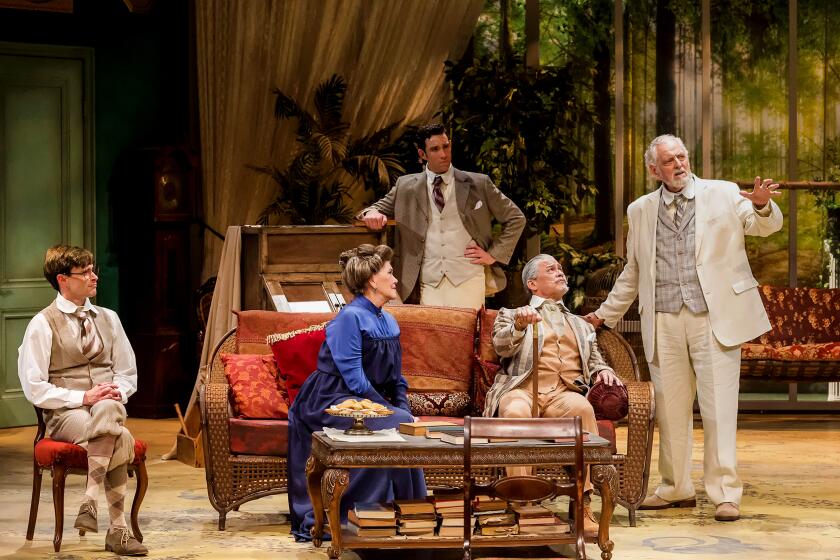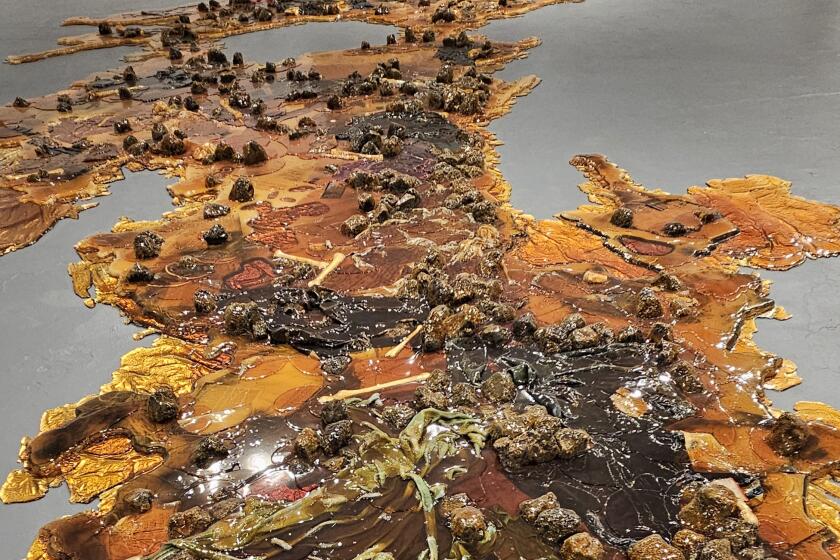Kaleidoscope Alters Views of the Border
At one point in the Border Art Workshop’s current show, visitors are instructed to lie on their backs on a small cart and propel themselves through a low, narrow tunnel. A light mounted on the end of the cart illuminates the roof of the tunnel, which is decorated with a sequence of doors--some painted gold, some papered with naturalization applications or studded with keys and door handles. Photographs and commentary on the doors describe how Richard Lou installed a single door on the border near the Tijuana airport and distributed its keys to impoverished residents nearby.
The performance (and this subsequent installation) was a gesture of hope that transformed the border from a political boundary to a stage for intimate social interactions. Although the act is symbolic, its implications are far-reaching, and by the time we are through the tunnel, we are in a different place not only physically but also psychologically.
Attitudes will shift and perspectives will be realigned throughout “Border Realities IV: Casa de Cambio,” at the Centro Cultural de la Raza through July 17. The show’s labyrinthine course of confrontations, disturbances and truths proves an intense and disorienting experience, one that leaves an enduring imprint. The six Border Art Workshop/ Taller de Arte Fronterizo members and eight collaborators who embarked on this ambitious project succeed consistently in evoking the power of symbol and metaphor, from the show’s title through its multifarious parts.
In its common usage, casa de cambio refers to the type of currency-changing operation that clutters the border. Literally translated, it means “house of change,” and this house, haunted as it is by discomfiting realities, is bound to change you. Rather than representing the border through static imagery that could be perused at a distance and then passed over, “Casa de Cambio” puts its guests into all-embracing situations where they are prompted to redefine what the border, amnesty and immigration mean in personal terms.
Victor Ochoa’s “Border Stereotypes,” for instance, asks visitors to try out several different identities for themselves, by placing their faces in the various openings of a vividly painted group portrait. The strategy harks back to fun house frolics and tourist photo opportunities, but here the game has a sharp, serious edge. Seeing oneself in the mirrored wall opposite--as a maquiladora worker in hermetic gear assembling cassette decks for a Japanese company, as an INS guard choking a young alien, as an agricultural worker on hands and knees in the dirt, or as a contemptuous missionary toting two forms of subjugation, a missile and missal-- becoming these “types” even for an instant forces a self-examination and assessment of such “typical” representations.
Misconceptions about people and places are exposed in “There’s No Place Like Home” (by Michael Schnorr and Berta Jottar), a room mimicking the perfect American patio, with its AstroTurf flooring, white picket fence and miniature American flags. Stills on one wall demonstrate how characters of Mexican descent have been stereotyped in popular films, and images from popular illustration show how such racist imagery has been perpetuated by depicting Mexicans as “sombreroed, seraped, huarached and mustached.”
A video shown within this mock domestic setting contrasts the media’s portrayal of the Tijuana-San Ysidro region as hostile and violent with accounts of the same area from its residents, who describe it as a calm, hospitable neighborhood. Assorted stills from “Erasing the Line: Backyard to Backyard” (by Schnorr, Jottar and Alicia Flores) are mounted on another wall, with captions that reiterate the conflicting views. One frame is left vacant, with the caption “Y Usted? (And you?),” that asks viewers to reconsider how they construct their opinions on the border, and where they fit along the spectrum of possible interpretations.
Although some of the installations here chip away gently at misconceptions and distortions, others hammer away at lies, so that the show never lapses into the monotonous harangue that politically oriented art is prone to. Instead, the tone varies constantly, from parody to indictment, from instruction to poetry.
One of the most effective sections of the show, “Magic of the Marketplace” (by Schnorr and Deborah Small), uses horrendously offensive quotes by INS Regional Commissioner Harold Ezell as a springboard for unmasking the racism and desire for exploitation latent in U.S. policy toward illegal immigrants. Ezell’s suggestion that “If you catch an alien, you ought to clean ‘em and fry ‘em yourself”--which appears on the side of a boat--implies governmental support for the rash of vigilante acts against undocumented workers in this county in recent years. Such dehumanization of illegal immigrants makes exploitation and violence permissible, even comfortable.
An electronic message board here spews out the deal that the government offers to immigrants from the south: “We welcome you, but first we must fingerprint you, interrogate you, probe you, scope you. . . . We exempt you, we absolve you, we exonerate you, but only if you qualify for our benevolence. . . . We forgive you, but first we must certify you, standardize you, normalize you, merge you, melt you, validate you, authenticate you, assimilate you. . . . We want your blood, we’ll give you trickle down theories. . . . We want your sweat, we’ll give you annual yields. . . . We want your dreams, we’ll give you the AMERICAN DREAM . . . .”
Along the way, the message, and the show in general touch on amnesty’s multiplicity of meanings--for some it is a dream, for others a nuisance, for some a right, and others a favor. “Border Realities IV” mixes the vocabularies of politics, art, poetry, history and sociology to present a kaleidoscopic view of the border. At times it is chaotic, and at times, sophisticated, but always it is true, engaging and immensely important. It is a show--one of the very few--that really makes a difference.
More to Read
The biggest entertainment stories
Get our big stories about Hollywood, film, television, music, arts, culture and more right in your inbox as soon as they publish.
You may occasionally receive promotional content from the Los Angeles Times.






